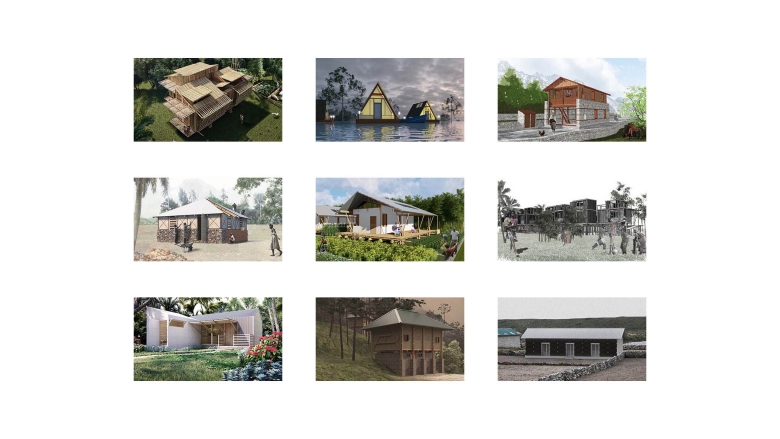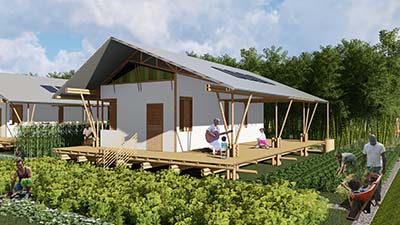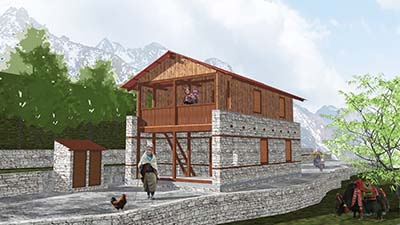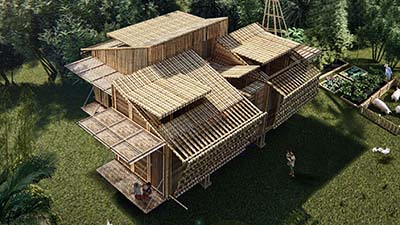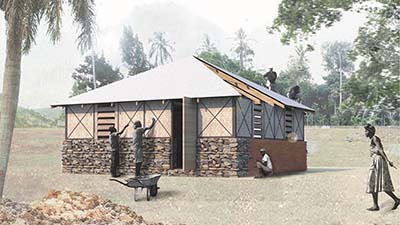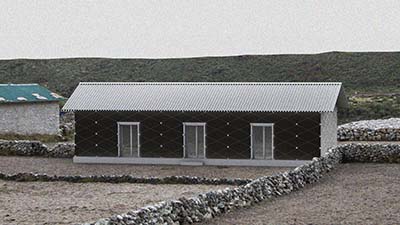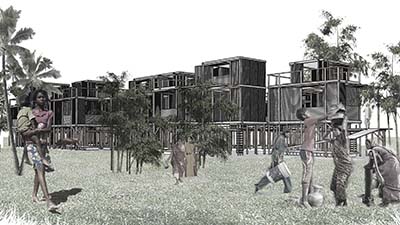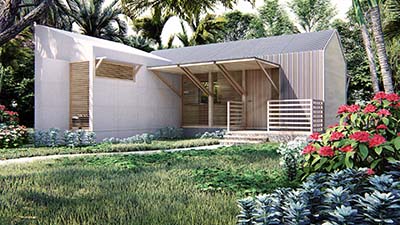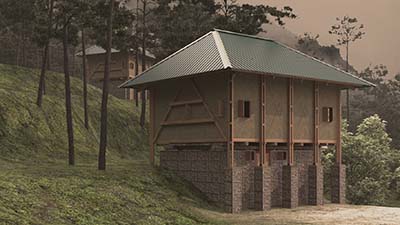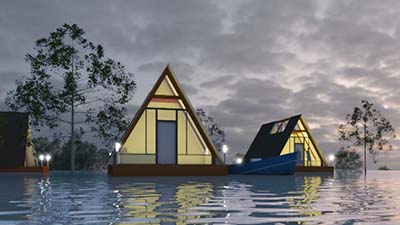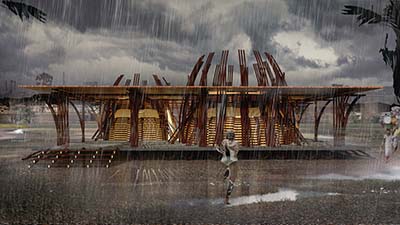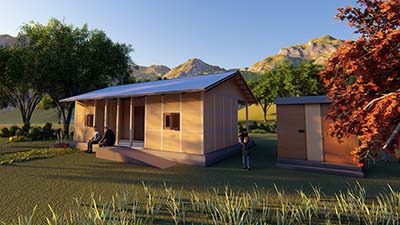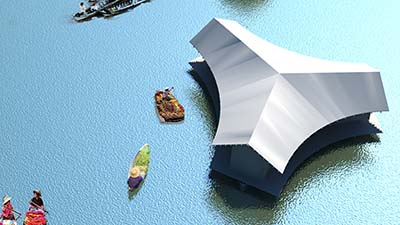Winning Teams
Scenario 1: Caribbean Islands
The proposed dwelling is fabricated in its majority out of bamboo, a low cost, highly sustainable and renewable building material, widely available worldwide, lightweight, durable, flexible, easily cultivated and harvested. Its quick growth and easy handling make it an ideal material for beautiful low-cost housing.
Local Context: The positioning of the dwelling should be placed with the 22.5-degree side of the roof facing south for optimum sun exposure. Bamboo planting can reduce soil erosion, restore depleted lands, and provide economic opportunities. It also performs well in hot and humid climates.
Resilience: A guadua bamboo framed structure rests on 9 concrete piers and is elevated off the ground for maximum resilience in areas of flooding. The bamboo frame is naturally a flexible structure, great in both tensile and compressive strength. With reinforced joints, the seismic resistant structure can sustain hurricane winds.
Construction Process & Ease: The construction should be contract driven unless the owner has experience with the treatment process and joining methods of bamboo. Once taught, all future construction phases can be owner driven. Apart from the bamboo frame, the construction follows traditional methods.
Team: Jordanna Ebanks, Vanessa Estevez, Angela Johnson, Jaya Kader, Gonzalo Otaola
Scenario 2: Nepal, Laprak Village, Alpine Climate
The critical reflection of what has been done and what could have been done, has been the point of departure. After 2015 Earthquake, so called model houses with rigid plans and modern materials are being constructed. This has not only disturbed the vernacular essence but also disregarded the ecological, cultural and economic aspects of rural Nepal.
Therefore, instead of new technology in the name of innovation, our design uses the situated construction knowledge in an efficient way. The proposed plans respond to local environment and allow the daily activities. Also, the modular system helps for the rapid reconstruction of houses.
Team: Ananda Manandhar, Prakriti Bhandari, Saurav Koirala, Saurav Shrestha, Sona Bade, Suraj Lama
Scenario 3: Philipines – Sorsogon
The purpose of our project is to provide first and foremost a safe, sustainable refuge for disaster stricken regions of the world. More specifically to those facing tropical hurricanes and their outcomes.
The result is a home that can float to avoid the rising waters from seasonal floods and can resist hurricane winds due to a compact design and a pitched roof.
Team:
Francesca De Filippi, Matteo Gianotti, Roberto Pennacchio Matteo Robiglio, Elena Vigliocco, Marco Simonetti, Laura Munoz Tascon,Simone parola, Maria Vélez, Zhang xinyun, Ma Xingyu, Manuela Reitsma, Alessandro Scarfiello, Francesco Sorasio, Florencia Courroux. Ferhat Dural. Hadi Charafeddine, Fernanda Souza Povoa, Luca Anselmino. Tzlil Lussato, Mirela Dadaj, Ghazal Amiri, LI biao, Ramezanzade.
Scenario 1: Haiti (Hot summers and mild winters)
This house was built in 2013 in Haiti, in the framework of a rehabilitation programme. Conceived for 4/5 person family house, it represents an effective model for post-disaster housing reconstruction and development projects. The CSW technology – Confined Stone Walls – is a smart, low tech and cost effective construction process for rural housing, inspired by vernacular stone wall architecture. The construction process is dry (no masonry required) and the wire mesh and cages can be manufactured on site, thus benefitting from local materials and limiting the need for imported materials (and their associated transport costs and environmental impact).
Team: Samanta Maria Lucrezia Tumbarello, Ludovic Jonard
Scenario 2: Central Asia rural alpine regions (Thame Valley, Nepal)
The design transforms existing rural alpine construction techniques into a resilient, modular and flexible core home unit. It does this by reconfiguring common building materials into a novel structural lattice system to counter the six typical earthquake induced structural failures. The precise, yet adaptable system has been developed from local post-earthquake evolution, typology research and a constructed prototype in the Thame Valley, Nepal. The knowledge has been customised to an essential domestic spatial unit that meets the immediate spatial requirements of rural alpine populations while allowing for adaptability and incremental development.
Team: Varun Kaushik, David Stoeger, Ngawang Sherpa, Scott Lloyd
Scenario 3: Bangladesh (Ranigaon) Hot summers with areas with heavy rainfall
The BAM-S House is designed to be the new contermporary vernacular architecture to face the wide range of climate change effects that has hit Bangladesh increasingly. It‘s typology is based on the Stilt House adressing contemporary design and structural reinforcement. It allows high quality of scalability, expandability and community aggregation. It’s ease to built and can be replicable in other rural or urban contests. Its construction phases are adapted to different uses and target people.The owner driven contruction approach associated with the ODS#1make it economically feasible, it saved around 30% of total budget. Bamboo is the material that makes possible to converge all needs into a single choice. The BAM-S House is much more than a resilient house, it’s smart. The energy efficiency of the building are present in all of it’s aspects and sustainaibility go beyoung the building itself.
Team: Santiago Caprio, Claudia Azzolin, Marco Asciutti, Romarie Gonzalez, Andrea Galli, Samar Elsayed, Ivo Kieling, Alex Pedretti, Luiza Macedo, Thiago Farias
Scenario 1: Island countries in the Caribbean (particularly Dominica, Antigua & Barbuda, Saint Kitts & Nevis, Dominican Republic, Haiti and the Virgin Islands among others)
The Antu resilient home is a modular house capable of resisting the shocks of category-five hurricanes in the Caribbean. Resilience principles and a Built Back Better approach are integrated to safeguard people’s lives and to regenerate rehabilitation after the occurrence of a major event. A resilience network is envisioned to ease emergency operations and reduce life losses. The home is designed considering ground realities, local capacities and the challenges made evident by Hurricanes Irma and Maria. Within the home, the open spaces foster expandability and a horizontal integration within the family members and shape a gender and age balanced home.
Team: Ana Sabina Thomas, Ingrid Hamm Rios, Paola Gradiz Fonseca, Virginia Chavarria Elvir, Noel Sampson
Scenario 2: Uttarkashi, Uttarakhand, India
The main challenge in this scenario is to design a house that is not only earthquake and landslide resilient but also takes into account the increasing remoteness and difficulty in transport as altitude rises. The house is designed with a heavy stone filled retaining wall at the bottom and a light wooden structure on the top. Materials and technologies that would be easily available in the local context and can be easily transported via small pickup van are used. A balance between local knowledge and modern construction techniques is incorporated in order to encourage community participation and ownership. Earthquake resilient features are integrated into the traditional building practices with minor changes to the available skill set so that its construction does not require expert or non-local craftsmen.
Scenario 3: Kelantan, a state located in the East Coast of Malaysia, experiences intense recurring monsoon season at the end of every year.
The design focuses on the flood-affected victims. How can we ease their flood survival efforts from inception to post-flood for years and years to come? Our solution simplifies the process down to just the palm of their hands – via mobile application.
Flood victims are able to purchase their resilient homes via mobile app based on their financial and physical capacities. Manufacturing the design in modules enables this intention to follow through and prolong its significance with high expandibility, scalability and sustainability nature.
With the flood and storm resilient design it possesses, the resilient home is able to increase the chances of survival for the victims and their belongings through its ability to float. This amphibious feature is what carries its branding – the Apung House (Floating house).
Part of the factor in resilient designs often neglected is Social Resilience. Handing in the power of choice to the flood victims to select their home is the very first important step towards resilient architecture because although builtform executes the work, it all started from a healthy and worry-free mind.
Team: Voon King Howe, Ong Yee Fei, Ahmad Farhan Izhan, Mohd Nurhuari Yahya, Nurin Mansoor
